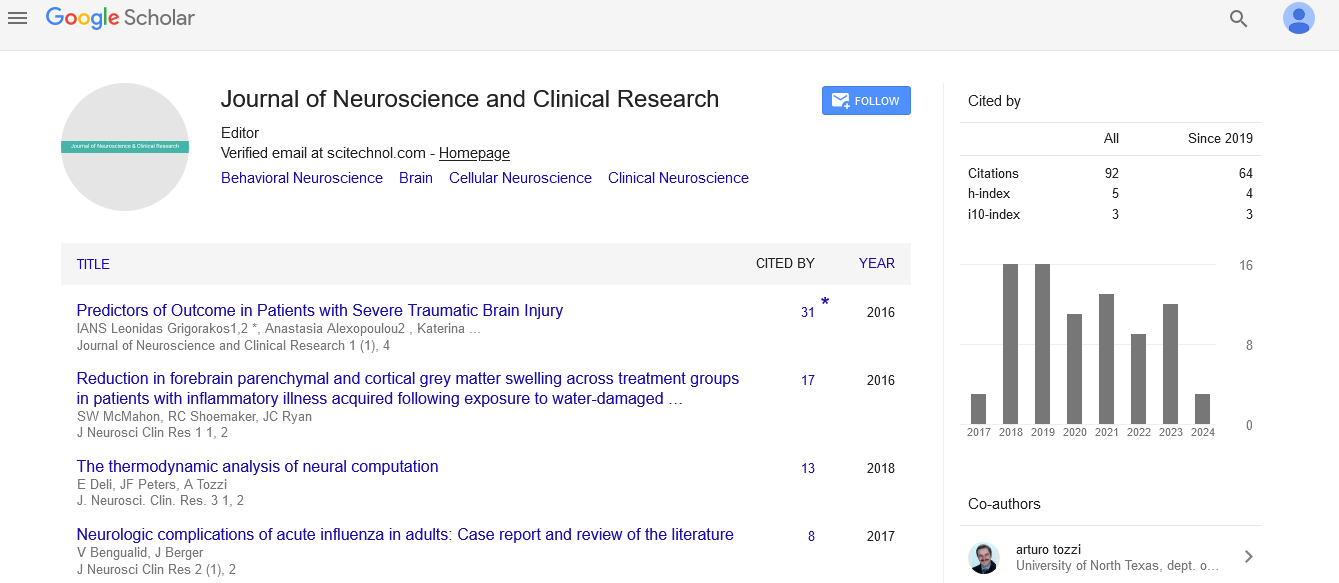Perspective, J Neurosci Clin Res Vol: 9 Issue: 2
Functional Connectivity in Neural Circuits of Anxiety and Depression
Chiang Kyoungh*
1Department of Neurology, The First Affiliated Hospital of Chongqing Medical University, Chongqing, China
*Corresponding Author: Chiang Kyoungh,
Department of Neurology, The First
Affiliated Hospital of Chongqing Medical University, Chongqing, China
E-mail: kyoungh@gmail.com
Received date: 28 May, 2024, Manuscript No. JNSCR-24-137131;
Editor assigned date: 30 May, 2024, PreQC No. JNSCR-24-137131 (PQ);
Reviewed date: 14 June, 2024, QC No. JNSCR-24-137131;
Revised date: 21 June, 2024, Manuscript No. JNSCR-24-137131 (R);
Published date: 28 June, 2024, DOI: 10.4172/Jnscr.1000198
Citation: Kyoungh C (2024) Functional Connectivity in Neural Circuits of Anxiety and Depression. J Neurosci Clin Res 9:2.
Description
Stress is an inevitable part of life, but when it becomes chronic or overwhelming, it can have profound effects on the brain and overall mental health. Anxiety and depression, two of the most common mental health disorders, are often exacerbated by stress and can significantly alter neural function. Understanding how these conditions impact the brain provides valuable insights into their mechanisms and potential treatments. The brain's response to stress is orchestrated by the Hypothalamic-Pituitary-Adrenal (HPA) axis. When a stressor is perceived, the hypothalamus releases Corticotropin-Releasing Hormone (CRH), which signals the pituitary gland to secrete Adrenocorticotropic Hormone (ACTH). This, in turn, prompts the adrenal glands to produce cortisol, the primary stress hormone. Cortisol helps the body manage stress by increasing energy availability, but chronic elevation can be detrimental.
The amygdala, a key brain region involved in emotional processing, becomes hyperactive in individuals with anxiety and depression. This hyperactivity heightens the perception of threats and can lead to excessive fear and worry in anxiety or heightened emotional reactivity in depression. The Prefrontal Cortex (PFC), responsible for executive functions such as decision-making, impulse control, and regulating emotions, often exhibits reduced activity in those with anxiety and depression. This hypofunctionality can impair rational thinking and exacerbate negative thought patterns. The hippocampus, important for memory formation and emotional regulation, tends to shrink in size with prolonged stress and high cortisol levels. This atrophy is associated with difficulties in learning and memory, common in depression, and can exacerbate symptoms by making it harder to recall positive memories.
Often called the "feel-good" neurotransmitter, serotonin levels are typically lower in individuals with depression. This imbalance can affect mood, appetite, and sleep, contributing to the pervasive sadness and lethargy characteristic of depression. This neurotransmitter is involved in the body’s stress response and is often dysregulated in anxiety and depression. Elevated norepinephrine levels can lead to hyperarousal and anxiety, while low levels are linked to lack of energy and attention deficits. Dopamine is associated with the brain’s reward system. Dysregulation of dopamine pathways can diminish the ability to experience pleasure (anhedonia), a core symptom of depression, and contribute to the motivation deficits seen in both anxiety and depression.
Chronic stress can inhibit neurogenesis, the process by which new neurons are formed, particularly in the hippocampus. Reduced neurogenesis is linked to the persistence of depressive symptoms. Anxiety and depression can alter neural connectivity, particularly in the Default Mode Network (DMN), which is active during rest and self-referential thought. Dysregulation in the DMN can result in rumination, a common feature in both conditions. Cognitive impairments are common in both anxiety and depression. Both conditions can make it difficult to focus and maintain attention, impacting daily functioning and productivity. Short-term memory deficits are frequently observed, likely due to hippocampal dysfunction and the impact of chronic stress on the brain. Impaired decision-making and problem-solving abilities are often seen, linked to reduced prefrontal cortex activity.
Antidepressants, such as Selective Serotonin Reuptake Inhibitors (SSRIs), can help balance neurotransmitter levels and alleviate symptoms. Other medications, like benzodiazepines, may be used for acute anxiety relief. Cognitive-Behavioral Therapy (CBT) aims to reframe negative thought patterns and improve emotional regulation. Mindfulness-based therapies can also reduce stress and enhance prefrontal cortex function. Regular physical activity, a healthy diet, sufficient sleep, and stress management techniques can support brain health and mitigate the effects of anxiety and depression. Techniques like Transcranial Magnetic Sstimulation (TMS) and Electroconvulsive Therapy (ECT) can alter brain activity patterns and are used for treatment-resistant cases.
Conclusion
The brain's response to stress and its role in anxiety and depression are complex, involving intricate interactions between various neural pathways, neurotransmitters, and structural changes. By continuing to explore these relationships, we can develop more effective treatments and interventions, ultimately improving the lives of those affected by these pervasive mental health conditions. Anxiety and depression involve complex interactions between brain regions, neurotransmitter imbalances, and neural connectivity disruptions. Understanding these mechanisms informs treatments like medication, therapy, and lifestyle changes. Advances in techniques like TMS and ECT offer hope for treatment-resistant cases, emphasizing the importance of continued research and personalized care.
 Spanish
Spanish  Chinese
Chinese  Russian
Russian  German
German  French
French  Japanese
Japanese  Portuguese
Portuguese  Hindi
Hindi 